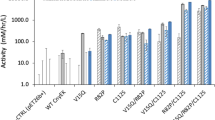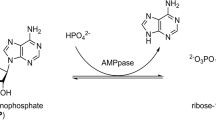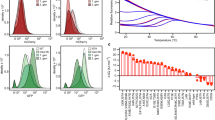Abstract
Expression of creatine kinase (CK) from a Torpedo californica electric organ cDNA in Escherichia coli results in an insoluble protein product with no detectable CK activity. Although this is a stable aggregate that can be isolated in an enriched form by centrifugation, initial attempts to generate enzyme activity by denaturing and refolding yielded only minute amounts of active protein. We find that these low recoveries are due to proteolysis of the CK during denaturation and refolding. While this proteolytic activity is not inhibited by either phenylmethanesulfonyl fluoride (PMSF) or EDTA, it can be largely removed from the CK aggregate by extraction with a detergent-containing buffer prior to denaturation. This treatment improves the recovery of active CK approximately 100-fold. We have also found similar proteolytic activity associated with the aggregate formed when a mutant of bovine pancreatic trypsin inhibitor (BPTI) is expressed in E. coli. Discovery of this proteolytic activity in two different expression systems suggests that it should be considered as a potential problem for recovery of active protein from other inclusion bodies as well.
This is a preview of subscription content, access via your institution
Access options
Subscribe to this journal
Receive 12 print issues and online access
$209.00 per year
only $17.42 per issue
Buy this article
- Purchase on Springer Link
- Instant access to full article PDF
Prices may be subject to local taxes which are calculated during checkout
Similar content being viewed by others
References
West, B.L., Babbitt, P.C., Mendez, B. and Baxter, J.D. 1984. Creatine kinase protein sequence encoded by a cDNA made from Torpedo californica electric organ mRNA. Proc. Natl. Acad. Sci. USA. 81: 7007–7011.
Weir, M.P. and Sparks, J. 1987. Purification and renaturation of recombinant human interleukin-2. Biochem. J. 245: 5–91.
Sharma, S.K., Evans, D.B., Tomich, C.-S.C., Cornette, J.C. and Ulrich, R.G. 1987. Folding and activation of recombinant human prorenin. Biotech. Appld. Biochem. 9: 181–193.
Mitraki, A. and King, J. 1989. Protein folding intermediates and inclusion body formation. Bio/Technology 7: 690–697.
Marston, F.A.O. 1986. The purification of eukaryotic polypeptides synthesized in Escherichia coli. Biochem. J. 240: 1–12.
Schein, C.H. 1990. Solubility as a function of protein structure and solvent components. Bio/Technology 8: 308–317.
Schein, C.H. 1989. Production of soluble recombinant proteins in bacteria. Bio/Technology 7: 1141–1149.
Marston, F.A.O. 1987. The purification of eukaryotic polypeptides expressed in Escherichia coli 59–88. In: DNA Cloning: a Practical Approach (Vol. 3). Glover, D.M. (Ed.). IRL Press, Oxford, United Kingdom.
Lim, W.K., Smith-Somerville, H.E. and Hardman, J.K. 1989. Solubilization and renaturation of overexpressed aggregates of mutant tryptophan synthase α-subunits. Appl. Environ. Microbiol. 55: 1106–1111.
Hoess, A., Arthur, A.K., Wanner, G. and Fanning, E. 1988. Recovery of soluble, biologically active recombinant proteins from total bacterial lysates using ion exchange resins. Bio/Technology 6: 1214–1217.
Bolyard, M.G. and Lord, S.T. 1988. High-level expression of a functional human fibrinogen gamma chain in Escherichia coli. Gene 66: 183–192.
Nagai, K. and Thøgerson, H.C. Synthesis and sequence-specific proteolysis of hybrid proteins produced in Escherichia coli. Meth. in Enzymol. 153: 461–481.
Altman, J., Nilsson, B., Anderson, S. and Kuntz, I.D. 1990. Manuscript in preparation.
Babbitt, P.C., West, B.L., Kuntz, I.D. and Kenyon, G.L. 1988. Purification of the insoluble aggregate obtained from the expression of creatine kinase in E. coli yields greatly improved specific activity in the refolded protein. Biochem. 27: 3093.
Holmes, D.S. and Quigley, M. 1981. A rapid boiling method for the preparation of bacterial plasmids. Anal. Biochem. 114: 193–197.
Hartley, D.L. and Kane, J.F. 1988. Properties of inclusion bodies from recombinant Escherichia coli. Biochem. Soc. Trans. 16: 101–102.
Babbitt, P.C., West, B.L., Buechter, D.D., Chen, L.H., Kuntz, I.D. and Kenyon, G.L. Recovery of active creatine kinase refolded from inclusion bodies in Escherichia coli can be improved by removal of a contaminating protease. In: Protein Refolding. Georgiou, G. (Ed.). American Chemical Society, New York. In press.
Amann, E., Brosius, J. and Ptashne, M. 1983. Vectors bearing a hybrid trp-lac promoter useful for regulated expression of cloned genes in Escherichia coli. Gene 25: 167–178.
Meselson, M. and Yuan, R. 1968. DNA restriction enzyme from E. coli. Nature 217: 1110–1114.
Grossman, S.H., Pyle, J. and Steiner, R.J. 1981. Kinetic evidence for active monomers during the reassembly of denatured creatine kinase. Biochem. 20: 6122–6128.
Creighton, T.E. and Goldenberg, D.P. 1984. Folding pathway of a circular form of bovine pancreatic trypsin inhibitor. J. Mol. Biol. 179: 497–526.
Lowry, O.H., Rosebrough, N.J., Farr, A.L. and Randall, R.J. 1951. Protein measurement with the folin phenol reagent. J. Biol. Chem. 193: 265–275.
Bradford, M.M. 1976. A rapid and sensitive method for the quantita-tion of microgram quantities of protein utilizing the principle of protein-dye binding. Anal. Chem. 72: 248–254.
Tanzer, M.L. and Gilvarg, C.J. 1959. Creatine and creatine kinase measurement. J. Biol. Chem. 234: 3201–3204.
Laemmli, U.K. 1970. Cleavage of structural proteins during the assembly of the head of bacteriophage T4. Nature 227: 680–685.
Author information
Authors and Affiliations
Rights and permissions
About this article
Cite this article
Babbitt, P., West, B., Buechter, D. et al. Removal of a Proteolytic Activity Associated with Aggregates Formed from Expression of Creatine Kinase in Escherichia coli Leads to Improved Recovery of Active Enzyme. Nat Biotechnol 8, 945–949 (1990). https://doi.org/10.1038/nbt1090-945
Received:
Accepted:
Issue Date:
DOI: https://doi.org/10.1038/nbt1090-945



